#the madwoman in the attic
Text

the madwoman in the attic
263 notes
·
View notes
Text
Reading the writing of women from Jane Austen and Charlotte Brontë to Emily Dickinson, Virginia Woolf, and Sylvia Plath, we were surprised by the coherence of theme and imagery that we encountered in the works of writers who were often geographically, historically, and psychologically distant from each other. Indeed, even when we studied women's achievements in radically different genres, we found what began to seem a distinctively female literary tradition, a tradition that had been approached and appreciated by many women readers and writers but which no one had yet defined in its entirety. Images of enclosure and escape, fantasies in which maddened doubles functioned as asocial surrogates for docile selves, metaphors of physical discomfort manifested in frozen landscapes and fiery interiors—such patterns recurred throughout this tradition, along with obsessive depictions of diseases like anorexia, agoraphobia, and claustrophobia.
The Madwoman in the Attic by Sandra M. Gilbert and Susan Gubar
#the madwoman in the attic#sandra m. gilbert#susan gubar#quote#literature#dark things#feminist literature#dark academia#aesthetic#jane austen#Charlotte Brontë#emily dickinson#virginia woolf#sylvia plath#on writing
716 notes
·
View notes
Text



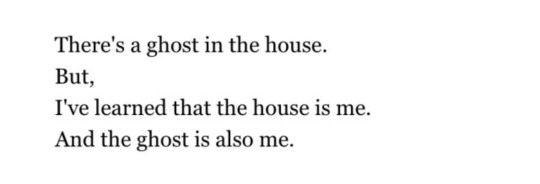






Jane Eyre / Haunted Houses as physical manifestation of trauma
#jane eyre#the madwoman in the attic#web weaving#haunting of hill house#the haunting of hill house#shirley jackson#horror#gothic literature
468 notes
·
View notes
Text
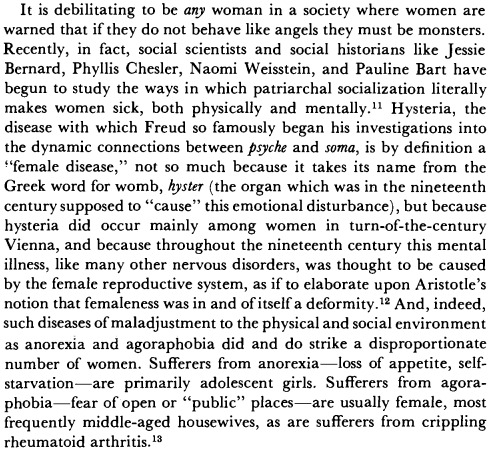






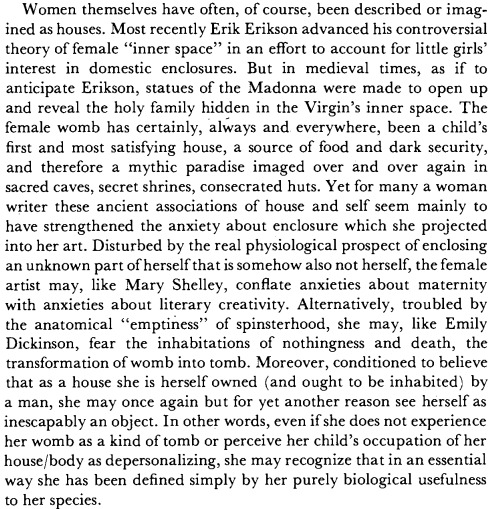
- The Madwoman in the Attic: The Woman Writer and the Nineteenth-Century Literary Imagination
58 notes
·
View notes
Text

From The Madwoman in the Attic by Gilbert and Gubar
“She had unclear ideas about marriage. In her reasoning, beyond the knowledge that husband and wife were a man and a woman who called each other ‘hanım!’ and ‘bey!’, all else would get so lost in clouds of confusion that she found it impossible to follow any inferences. For her, only one thing was important: while a door was closing between herself and her father, an elegant door decorated with blue satin and white tulle had opened between him and a strange woman…
After that day, she had never entered those rooms again; but she could not forget the white shawl that Bülent had found. When she heard footsteps and giggles from beyond the door, she always imagined the white shawl. Ah, God, what is it? This shawl that so haunted the child’s mind, that intruded in her sleep?…
In particular, she could not bear to see the two of them together. The necessity of being with them at the table was an unavoidable torment. Those first days, Nihal had determined not to break her habit, to again fill the hours spent at the table with her usual chatter; but in the small talk she found, in the laughter she scattered between the small talk, and even in the silence of those who obligingly listened to her, in their smiles, she had noticed such a false tone, as if caused by pressing down on the wrong fret, that one day she had invented an unwarranted petulance and left the table. Since that day, she preferred a persistent silence at the table.”
(Aşk-ı Memnu, Chapter 5)
#wuthering heights#aşk ı memnu#aşk-ı memnu#the madwoman in the attic#madwoman in the attic#nihal#bihter#adnan bey#hindley earnshaw
22 notes
·
View notes
Text







‘Looking Oppositely: Emily Brontë’s Bible of Hell’, in The Madwoman in the Attic, Sandra M. Gilbert and Susan Gubar
#trying again#wuthering heights#emily bronte#the madwoman in the attic#sandra m. gilbert#susan gubar
53 notes
·
View notes
Photo

The Madwoman in the Attic, Sandra Gilbert and Susan Gubar
115 notes
·
View notes
Text
My new favorite way to pass the time is to read classic literary criticism texts and then use them to analyze films. So far I’ve paired:
"Compulsory Heterosexuality and Lesbian Existence" by Adrienne Rich with The Birds (1963).
"A Cyborg Manifesto" by Donna Haraway and Titane (2021). *Got the idea for this from an essay on hyperallergenic.com.
The Madwoman in the Attic: The Woman Writer and the Nineteenth-Century Literary Imagination by Sandra Gilbert and Susan Gubar and Little Women (2019).
Next I’m thinking of pairing The Anxiety of Influence: A Theory of Poetry by Harold Bloom with Scream (1996). Any film/literary criticism nerds out there with other recommended pairings, please let me know your suggestions!
#my own nerdy film club for one#adrienne rich#donna haraway#sandra gilbert and susan gubar#harold bloom#compulsory heterosexuality and lesbian existence#a cyborg manifesto#the madwoman in the attic#the anxiety of influence#the anxiety of authorship#just film nerd things#english majors in recovery
20 notes
·
View notes
Photo
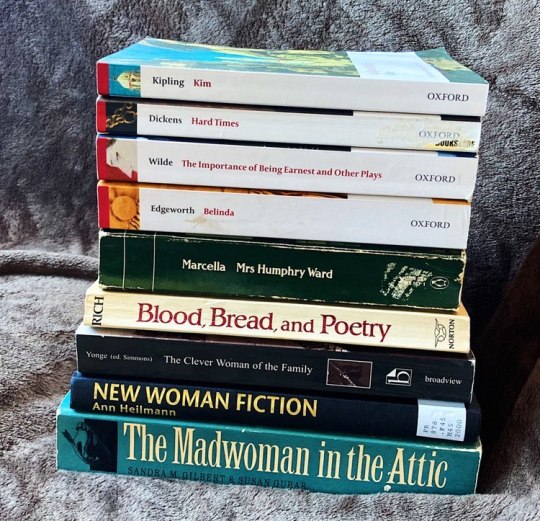
August Wrap Up
Well, this month has sucked. And that’s all I have to say about that.
Books Read: 15
But at least I read a lot. My favorite by far was Babel, and I really don’t have a least favorite. There was nothing under 3.5 stars. But seriously, go check out Babel, it’s freaking amazing. Books marked with ® are rereads.
Belinda by Maria Edgeworth - 5 stars
Blood, Bread, and Poetry: Selected Prose, 1979-1985 by Adrienne Rich - 4 stars
New Woman Fiction: Women Writing First-Wave Feminism by Ann Heilmann - 4 stars
Hard Times by Charles Dickens - 4.5 stars ®
Lady Windermere’s Fan by Oscar Wilde - 4 stars
The Clever Woman of the Family by Charlotte Mary Yonge - 4 stars
The Madwoman in the Attic: The Woman Writer and the Nineteenth-Century Literary Imagination by Sandra Gilbert and Susan Gubar - 4 stars
The Importance of Being Earnest by Oscar Wilde - 4 stars
Victorian Women’s Fiction: Marriage, Freedom, and the Individual by Shirley Foster - 4 stars
The Proper Lady and the Woman Writer: Ideology as Style in the Works of Mary Wollstonecraft, Mary Shelley, and Jane Austen by Mary Poovey - 3.5 stars
Kim by Rudyard Kipling - 3 stars
Babel, or the Necessity of Violence: An Arcane History of the Oxford Translators’ Revolution by R. F. Kuang - 5 stars
Marcella by Mary Ward - 3.5 stars
Mrs. Warren’s Profession by George Bernard Shaw - 4 stars ®
The ‘Improper’ Feminine: The Women’s Sensation Novel and the New Woman Writing by Lyn Pykett - 4 stars
On Tumblr:
There’s some stuff here; mostly tags, but I did participate in the first half or so of the 1K Pages Readathon.
1K Pages Readathon August 2022
July Wrap Up
Book Quotes: Babel by R. F. Kuang
Tagged: Sequel Stack Challenge
Tagged: Pink Book Stack
Tagged: Yellow Book Stack
Reblogged: Queer Fantasy Recommendations
On the Blog:
Hey, look, there’s something here! What a miracle!
Book Review: Babel: An Arcane History by R. F. Kuang
On YouTube:
And there’s a nice selection here, as usual.
My INSANE August TBR
July Wrap Up - 8 Books for Jane Austen July and Exams!
A Bookish Birthday Haul
Underrated Victorian Recommendations #3
Currently Reading 8/15/22
GarbAugust Trashy Book Tag
#booklr#august wrap up#book photography#monthly wrap up#books#wrap up#the madwoman in the attic#sandra gilbert#susan gubar#new woman fiction#ann heilmann#the clever woman of the family#charlotte mary yonge#blood bread and poetry#adrienne rich#marcella#mary augusta ward#belinda#maria edgeworth#oscar wilde#the importance of being earnest#hard times#charles dickens#kim#rudyard kipling
22 notes
·
View notes
Text
#top ten shakespeare i think i huave covid moments. how does david tennant play richard ii as a terrible king a poet a#self-styled martyr a madwoman in an attic and a scared little boy all at once#richard ii
96 notes
·
View notes
Text
When Janelle Monae sets the place on fire at the end of Glass Onion, it's considered a powerful move, but when I, Bertha Mason--
103 notes
·
View notes
Text
Both in life and in art, we saw, the artists we studied were literally and figuratively confined. Enclosed in the architecture of an overwhelmingly male-dominated society, these literary women were also, inevitably, trapped in the specifically literary constructs of what Gertrude Stein was to call "patriarchal poetry." For not only did a nineteenth-century woman writer have to inhabit ancestral mansions (or cottages) owned and built by men, she was also constricted and restricted by the Palaces of Art and Houses of Fiction male writers authored. We decided, therefore, that the striking coherence we noticed in literature by women could be explained by a common, female impulse to struggle free from social and literary confinement through strategic redefinitions of self, art, and society.
The Madwoman in the Attic by Sandra M. Gilbert and Susan Gubar
#the madwoman in the attic#sandra m. gilbert#susan gubar#quote#literature#dark academia#dark things#feminist literature#feminism#feminist art#misogyny#gertrude stein#on writing#patriarchal poetry
8 notes
·
View notes
Text
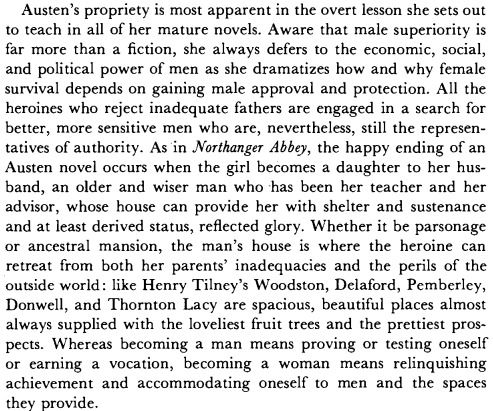

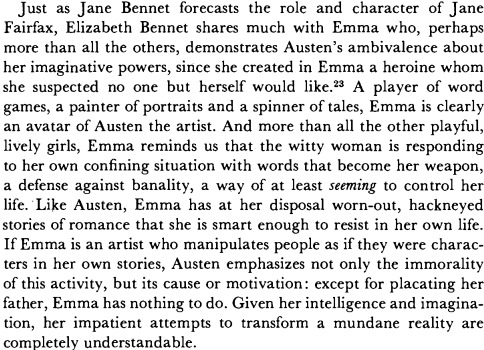
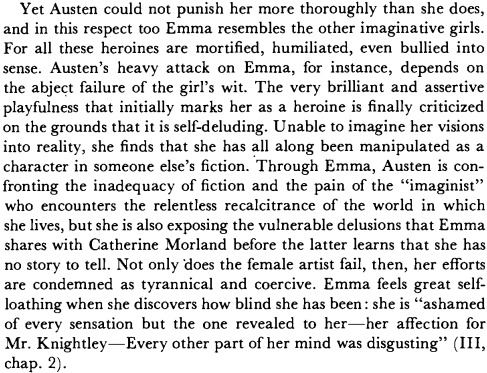

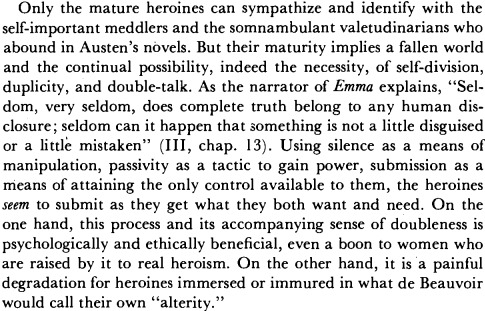

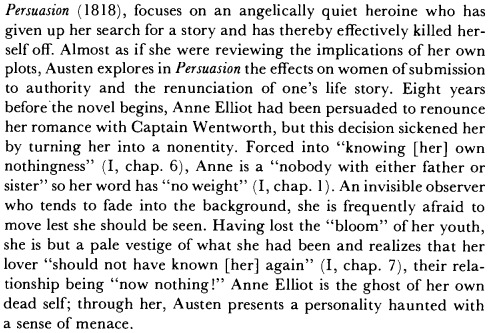

- The Madwoman in the Attic: The Woman Writer and the Nineteenth-Century Literary Imagination
30 notes
·
View notes
Text

From The Madwoman in the Attic by Gilbert and Gubar
I don’t really agree
6 notes
·
View notes
Text
Heathcliff’s presence gives the girl a fullness of being that goes beyond power in household politics, because as Catherine’s whip he is an alternative self or double for her, a complimentary addition to her being who fleshes out all her lacks the way a bandage might staunch a wound. Thus in her union with him she becomes, like Manfred in his union with his sister Astarte, a perfect androgyne.
‘Looking Oppositely: Emily Brontë’s Bible of Hell’, in The Madwoman in the Attic, Sandra M. Gilbert and Susan Gubar
66 notes
·
View notes
Text
Bertha Mason Rochester in Jane Eyre is called the "madwoman" because she lights beds on fire, stabs people, sneaks into rooms and rips veils, lights the house on fire. But when you look more closely at her actions, they make perfect sense. She sneaks out one night after ten years of being locked in the attic by her husband. Her caretaker has fallen too deeply asleep and Bertha has stolen the key. She does not injure her caretaker who is being paid to do a job. Bertha lights the bed of the man who is locking her up on fire. She never lunges for the maids who come to help tend her. But she stabs her brother who knowingly leaves her locked in an attic. When she is in a room with the woman who her husband is going to marry, she does not hurt the young, unknowing fiancée (Jane Eyre herself). Bertha rips up the veil that Jane will put on in the morning to marry Bertha's husband. Bertha doesn't hurt Jane: she warns her.
Fucking this, I said the same thing. Bertha never harms Jane, and she has the perfect opportunity to do so! (And I also see her ripping the veil as a warning to Jane.) She doesn't harm Grace or Leah or Mrs Fairfax. The only people she attacks are her husband and her brother--and the latter she couldn't have anticipated, bc Richard's visit was unannounced. When they all go upstairs after the crashed wedding, she doesn't go after Richard, or the vicar or the lawyer, or Jane--the only person she attacks is, once again, Rochester!
#madwoman in the attic#bertha antoinette mason#bertha mason#womens wrongs#female rage#and as always. there is no evidence that she started any fire#it's all hearsay
8 notes
·
View notes